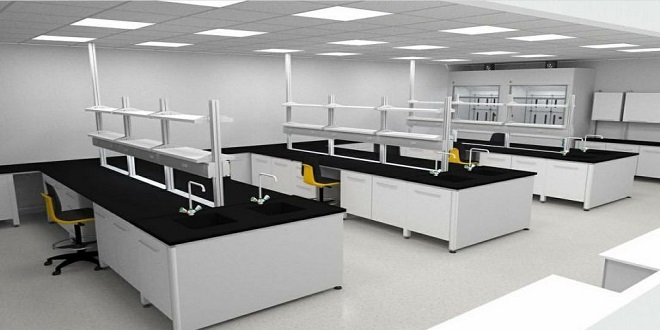Many people don’t understand that laboratories also typically include much furniture for laboratory use.
These pieces of lab furniture are built to last in the harsh conditions of the lab while still being adaptable enough to help with various tasks.
Labs typically have specialized equipment that helps scientists and researchers do their jobs more efficiently.
Numerous pieces of furniture are found throughout the laboratory. Because of the high volume of experiments performed in the lab, fixtures, and furnishings inside are built to tolerate a wide range of conditions.
The laboratory’s primary focus typically dictates the overall aesthetic of the space’s furnishings.
In this post, we are going to take a look at the types of laboratory furniture supplier layouts and dive into their pros and cons effectively:
Fixed-Layout Setups
To be functional for hands-on work, science labs must be outfitted with specialized machinery and have access to ancillary services.
This sets them apart from traditional classrooms. For example, certain schools use the option of installing long, fixed benches for their kids, with convenient access to the school’s underfloor services, i.e., water, electricity, and drainage.
Though conventional, the fixed bench plan serves its purpose well, providing both the teacher and students with a clear view of the entire classroom and enough desk area for hands-on projects.
However, one of the permanent desk structure’s most significant drawbacks is the decreased safety level.
Because fixed benches typically stretch across the width of the laboratory, it is difficult for teachers to reach pupils seated in the middle of each bank. This is especially hazardous if an accident takes place.
Therefore, all equipment must be put away after each training session, and gangways must be kept clear.
The fact that services are not always accessible beneath each student since they are located exclusively at particular spots throughout the room is an additional problem with the fixed bench plan.
Because students will need to walk about to complete their practical assignments, this configuration is not the best option. They may also be required to work with their backs turned to the instructor, which poses major dangers to their safety.
Service Pedestals & Tables
Many educational institutions put pedestals at various crossroads in the laboratory to conserve space and facilitate the connection of specific services.
These are typically large, floor-mounted systems that accommodate three or more workstations. The pedestals give students easy access to utilities like gas, electricity, and drainage for hands-on projects but don’t hog desk space for books and papers.
Because of its many advantages over a fixed-bench configuration, the service pedestal design is favored by many educational institutions. Since only the pedestal is set, benches can be rearranged as needed.
This makes it simpler to place desks together to enable practical group work and benefits students and teachers in terms of ease of access.
However, there are major drawbacks to using a service pedestal. Because the desks are set up, some students may find themselves with their backs or sides to the teacher, making it difficult to maintain eye contact and have a natural flow of conversation.
It’s also not a good idea to do practical experiments with your back to the teacher. Unsecured benches, especially those on rough surfaces, can be unsafe, noisy, and shaky; this is another drawback of the pedestal arrangement.
Custom Arrangements
These days, it’s very uncommon for schools to have laboratories of varying sizes and configurations, thanks to the prevalence of custom-built layouts.
The Hot Corner is one example of a specialized layout that is now on the market and can be used for practical and theoretical instruction. This cutting-edge apparatus satisfies the needs of a wide range of scientific fields thanks to its adaptable system and well-thought-out design.
The Hot Corner plan is more flexible for teachers and students than the “traditional” rows of desks since it combines practical and theoretical space on a single workstation.
In Hot Corners, the teacher moves to the classroom’s “long wall,” which reduces the distance between students and encourages more interaction and group work. In addition, because the desks and chairs are arranged in a single file, the pupils can’t turn their backs on the instructor.
Modular Lab Furniture
The mobility of modular laboratory furniture allows it to be quickly disassembled, relocated to a new location, and reassembled to create a fresh optimal configuration. The design of furniture provides a versatile and quick response to any situation.
Lab design is agile. They can be set up and delivered faster than a regular lab. Because it doesn’t need to attach consulting work to the ground or install huge, fixed tables and investigative components, a Modular lab may be bought and set up in minutes.
Modular laboratories often increase staff efficiency since they may be tailored to better accommodate individual work flows and personal preferences. You won’t have to worry about closed desks as much as you might in dedicated lab spaces. Instead, workers will be able to create straightforward motion patterns that support rather than inhibit productivity.
It’s well known that a lab update’s biggest challenge is availability. A more flexible lab would save downtime and boost productivity. Thus, the system works better.
The only disadvantage of the modular lab setup is the cost of setup. The cost price of such types of furniture hinders all the advantages, and buyers have to make a trade-off between aesthetics, portability, and money.





